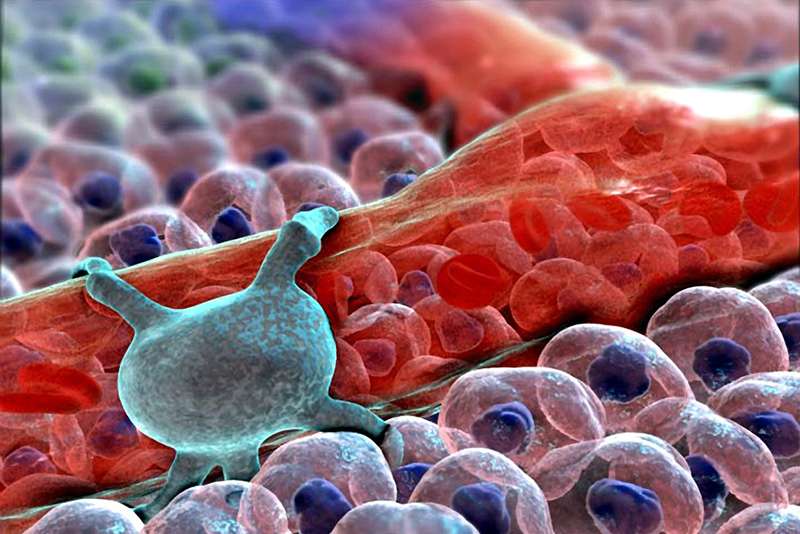Researchers find association between FOXF2 gene and blood vessel damage

Each year, stroke kills nearly 129,000 Americans, according to the American Stroke Association. It is the fifth leading cause of death in the United States and the top neurological cause of death and disability.
Scientists have associated a number of genes with a higher risk of stroke, especially—and predictably—genes involved with atherosclerosis and blood clotting. But they know little about the genes' biological mechanisms—how they actually work in the body and lead to stroke.
A study published in April 2016 in Lancet Neurology takes the link between genes and stroke one step further. The study not only identifies a gene called FOXF2 that is associated with stroke, but it also offers preliminary evidence on how the gene may cause stroke: by affecting pericytes, a type of cell on the walls of small arteries and capillaries. This insight is important, because pericyte damage is suspected to play a major role in Alzheimer's disease as well.
"It's exciting because this finding is important for both stroke and dementia, the two major neurological scourges of mankind," says senior author Sudha Seshadri, a Boston University School of Medicine (MED) professor of neurology, whose work is funded by the National Institute of Neurological Disorders and Stroke (NINDS), the National Institute on Aging, and the National Heart, Lung, and Blood Institute. "These results have given us a lot of interesting stuff to look at."
"Stroke is really a major public health issue," adds Stéphanie Debette, MED adjunct associate professor of neurology and also professor of epidemiology and neurology at the University of Bordeaux, who is the corresponding author on the study. "The known risk factors only explain a limited portion of the disease. It's important to unravel novel risk factors and mechanisms."
Seshadri says that scientists have discovered relatively few genes associated with stroke, as compared to other common diseases, and most have been the obvious contenders, affecting things like cardiac function and fat deposits. Hoping to find some "novel biology," as she says, Seshadri and colleagues at the Cohorts for Heart and Aging Research in Genomic Epidemiology (CHARGE) Consortium, where she leads the neurology working group, combined data from 18 previously published studies on stroke. They then analyzed the nearly 90,000 pooled cases—including about 4,300 stroke victims—using a technique called genome-wide association, which compares the genomes of stroke victims against those of healthy people and looks for significant genetic differences.
The analysis pointed to several interesting genes, including one called FOXF2. Seshadri, Debette, and colleagues also looked for—and found—evidence of FOXF2 malfunction in another large patient database through collaboration with the NINDS-funded Stroke Genetics Network, which contains more than 70,000 people, including 19,000 stroke victims.
"This was a surprising find," says Debette. "This was not a gene we had thought of; it was not known as a risk factor for people with stroke." FOXF2 has several functions. During fetal development, it helps build the blood-brain barrier, which separates circulating blood from cerebrospinal fluid, protecting the brain from neurotoxins. In adults, FOXF2 is also present in pericytes enveloping the small blood vessels that feed the brain. Scientists don't fully understand the pericytes' role but know that they help maintain the blood-brain barrier.
The team decided to follow the trail further. Coincidentally, Seshadri and Debette had begun to collaborate with other scientists studying FOXF2 equivalents in mice and zebrafish bred to have no copy, or a non-functioning copy, of the gene. Talking to these other scientists, they learned that both mice and fish developed small vessel disease, a condition in which the lining of small arteries and capillaries is damaged and the vessels become more porous. This discovery also matched up with reports of rare cases of small vessel disease in children, related to malfunctioning FOXF2. Although small vessel disease is an important cause of stroke, responsible for 20 to 30 percent of cases, scientists had not known about any genetic risk factors for common forms of the disease, and there is currently no treatment. "We know a lot about preventing and treating heart disease and atherosclerosis," says Seshadri, "but not much about preventing or treating small vessel disease."
Also, adds Debette, small vessel disease had been implicated in the tiny, "silent strokes" that contribute to a gradual decline in balance, memory, and cognition in many older people. The next research steps, she says, are detailed genetic sequencing to discern which variations of FOXF2 lead to the disease and more animal studies to refine these results.
"If we can better understand the biology of small vessel disease, maybe we'll find drug targets that could ultimately lead to treatments," says Debette. "If we could find a way to prevent the disease, it could have a major public health impact."
More information: Identification of additional risk loci for stroke and small vessel disease: a meta-analysis of genome-wide association studies, dx.doi.org/10.1016/S1474-4422(16)00102-2 , thelancet.com/journals/laneur/ … rticle/PIIS1474-4422%2816%2900102-2/abstract


















